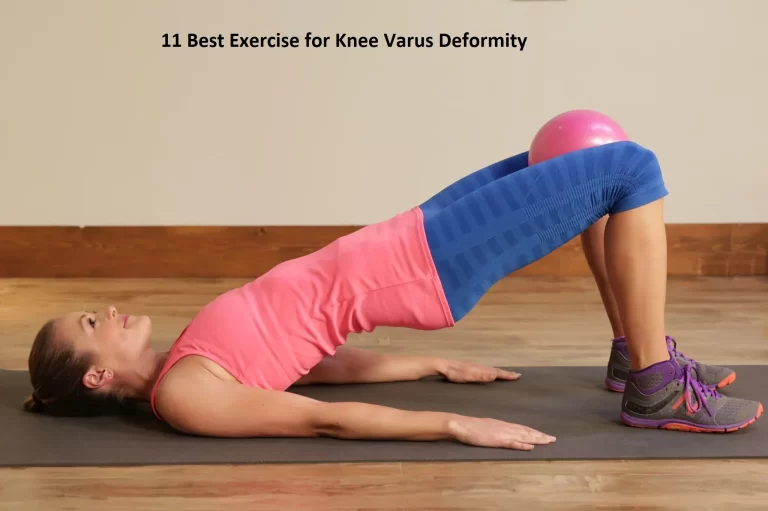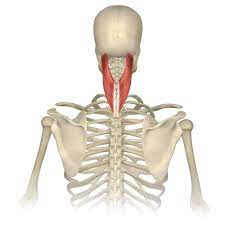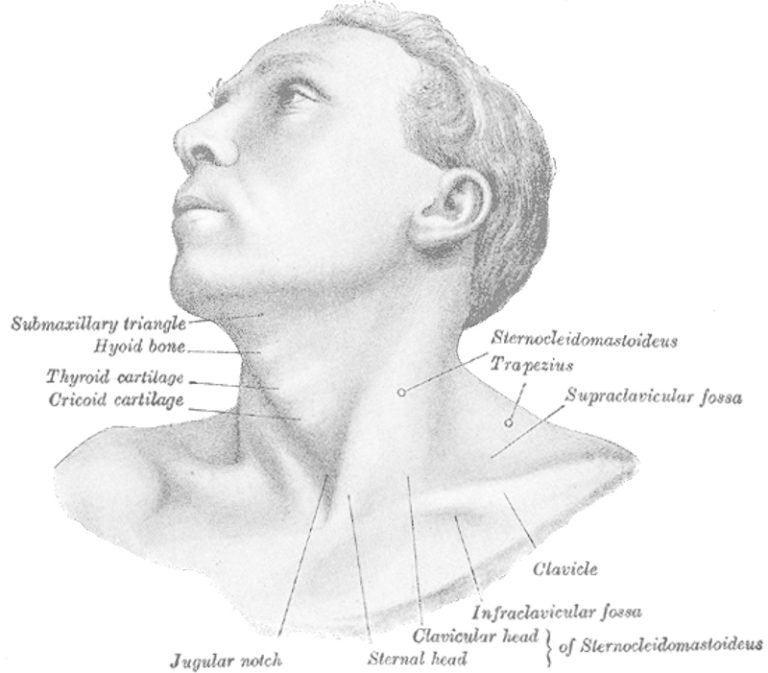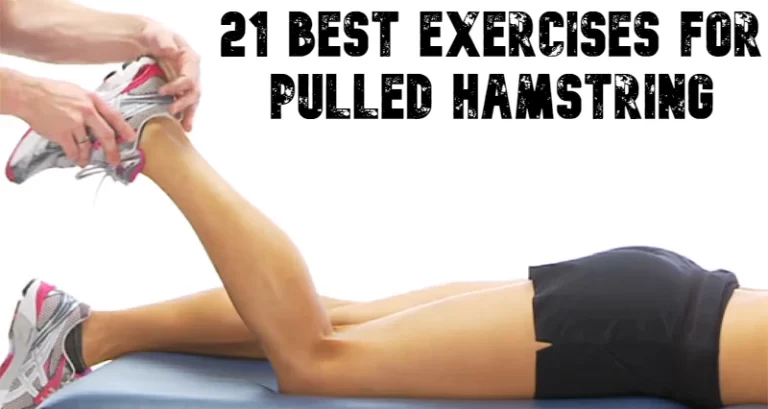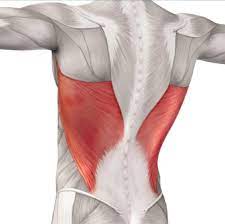11 Best Exercise for the Middle Back
Table of Contents
What are middle back exercises?
- The area of the back between the rib cage and the base of the neck.
- There are 12 backbones — the T1 to T12 vertebrae — located in this region. Disks are located between them.
- In middle back exercises, there are mainly two types of exercise: stretching exercise and strengthening exercise.
- Stretching helps in decreasing the tightness of the middle back muscles.
- Strengthening exercises help in improving the power of weak muscles in the middle back.
- Middle back pain causes include sports injuries, poor posture, arthritis, muscle strain, and accident injuries.
- Middle back pain is not as common as lower back pain because the thoracic spine does not move much in comparison to the spine in the lower back and neck.
- Pain in the middle of the back may be either acute or chronic.
- The pain can radiate to the shoulder, arm, or hand.
Muscles of the middle back:
- When mentioning the middle back, we mean the muscles in between your shoulder blades.
- These muscles are: Rhomboid major and minor, and middle and lower trapezius.
Health benefits of exercises for the middle back:
- Improve Back Posture
- Increase back flexibility
- Reduce tension
- Reduce middle Back And Shoulder Pain
Different exercises for the middle back :
Stretching exercises for the middle back:
- Cat-cow pose
- Opposite arm/leg raise
- Half cobra pose
- Active Thoracic Extension
- Needle and Thread
- Corner Stretch
- Open Book Stretch
- Seated twist
Strengthening exercises for the middle back:
- Resistance band pulls
- Passive backend
- Dumbbell row
Cat camel pose:
- Bend down on all fours with knees and hands on the floor.
- Gently tighten your lower abdominals, rounding the back towards the ceiling and tucking your chin. You should feel a stretch in your spine.
- Hold for 5 seconds.
- Release and return to the neutral position.
- Slowly raise your head, chest, and tailbone toward the ceiling, letting your spine and stomach sink toward the ground. This should also result in a comfortable stretch in your spine.
- Hold for 5 seconds.
- Release and return to the neutral position.
- Alternate between the two poses.

Opposite arm/leg raise:
- Get on your hands and knees. (tabletop position)
- The spine should be straight.
- Slowly extend one arm while extending the leg on the opposite side. Keep both straight and level.
- Hold for some deep breaths, then gently lower your arm and leg to starting position.
- Repeat this exercise with your other arm/leg.
- If you had a small tissue box balanced on your lower back it should remain in place throughout the exercise.
- Try for 12 to 15 repetitions on each side.

Half cobra pose:
- Lie on your stomach.
- Then lift your body up onto your elbows and hold it there a moment to check to see that it doesn’t hurt your lower back.
- If the lower back feels in pain in this position, skip this exercise, but it if feels good, make sure your chin is tucked in.
- Hold this for about 20 seconds.
- Repeat this 5 to 10 times.
Active Thoracic Extension:
- Start with a standing position.
- Put one foot forward, toes almost touching the wall, and put your hands behind your head, intertwining the fingers at the base of the skull.
- Then slide the elbows up the wall, hold for some seconds and slide back down.
- Try not to press too hard against the wall with your elbows and keep the elbows nearer together.
- Repeat 5-10 times slowly.
Needle and Thread:
- Start on the floor on all fours, with hands aligned under shoulders and knees under hips. (tabletop position)
- Inhale and raise your right hand up toward the ceiling, gently twisting your torso to the right.
- Exhale and turn back to the center, then thread your right arm into the space between your left hand and knee, to the point where you can lower your right shoulder and ear to the floor.
- Hold for 20 to 40 seconds and repeat on the other side.

Corner Stretch:
- Face the corner of a room.
- Stand with feet together, about 2 feet away from the corner.
- Put a forearm on each wall with the elbows slightly below shoulder height.
- Tilt forward until a good stretch is felt across the chest and shoulders. Your lower back should remain straight (as it is while standing).
- Hold the stretch for 30 to 60 seconds.
- If a corner is not available, another choice is to do this stretch in a doorway by placing the forearms on the door jambs (sides of the door frame).
- This stretch can be performed 4 to 5 times during the day.

Open Book Stretch:
- Begin by lying on the floor, placing your hips and knees at about a 90-degree angle.
- Squeeze a yoga ball (or similar item) between your knees for support. The additional squeeze will help fire up your lower spine and hips, allowing you to get a stronger thoracic turn from your chest and shoulder area.
- Squeeze your knees and drive your hip into the floor, then begin reaching your arm as far behind you as possible—again, as if you’re opening up the pages of a book.
- Twist with the intention of touching your wrist to the floor behind you.
- However, go as far as possible as your chest continues opening and stretching before returning to starting position.
- Go for another repetition, again squeezing your chest and shoulders throughout the stretch.
- Start with about four to five sets on each side, working anywhere from 30 to 60 seconds.
Seated twist:
- Begin by sitting on the floor, with your legs extended in front of you and your arms placed behind your back.
- Put your hands on the floor back of you with your fingers facing away from you.
- Take your left foot and place it flat on the floor on the outside and nearer to your right knee.
- Inhale and bring your right arm up.
- Exhale and pull your right arm down.
- Then place your elbow on the outside of your left leg.
- Twist your chest, head, and eyes to the left.
- Maintain this pose for about 3o to 60 seconds. Breathe.
- Slowly bring your head first and then your chest back to starting position.
- Now repeat on the other side.

Resistance band pulls:
- Stand straight with feet parallel and hip-wide apart.
- Holding a resistance band, raise your arms out in front of you at shoulder height.
- Keep your navel engaged and stand tall.
- Firstly inhale, and then on an exhale pull hands away from each other.
- Squeeze your shoulder blades together as your hands go away from each other, then slowly release back to starting position.
- Repeat four to five times for three sets, when you want to make it more challenging increase either the number of repetitions or move your hands closer together.
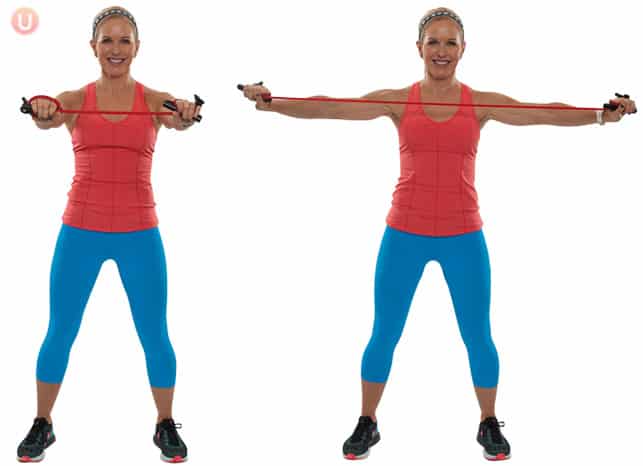
Passive backend:
- First Place the roll on the ground.
- You are lying on the roll so that it is rest under the shoulder blades, near the middle of the back.
- Try to place something under your head if needs any raise.
- Begin with arms away from the body & resting at a 45-degree angle.
- Hold this position for 1–3 minutes.
- Repeat this exercise 8-10 times in 1 session & perform 3 sessions per day.
Dumbbell row:
- This exercise is performed on all fours & with the use of a bench or a chair.
- Initiate this exercise with a dumbbell in each hand.
- Gently lift your elbow joint to bring the dumbbell in your right hand to your armpit.
- Keep your arm squeezed close to your body.
- When you are using a bench for this exercise, your left knee & hand stay on the bench.
- Your right leg rests on the floor as you row on the right side.
- Hold the exercise for 10 seconds.
- Repeat this exercise 8-10 times in 1 session & perform 3 sessions per day.
Precautions:
- Breathe throughout the exercise(Avoid breath-holding).
- Avoid excessive exercise
- Consult your doctor before starting any new exercise
- Take enough breaks during the exercise session
When not to do exercises for the middle back:
- If your Middle Back pain gets worse after exercise stop that exercises immediately
- Any recent surgery
- Any recent injury
- Infection
FAQ:
You should take a break from exercise if your middle back hurts a lot, but try not to let too much time pass before you get moving again. Instead, it’s good to return to your daily activities slowly.
It will improve your workouts. On top of that, you’ll have a better posture
you can perform middle back exercises up to three non-consecutive days a week. If you’re lifting heavy weights—enough that you can only complete six to eight repetitions—you’ll need two or more days of rest before you do the exercise again.
You should extend the stretch as far as you can without feeling any pain and maintain that position for 10 to 20 seconds.

